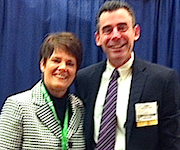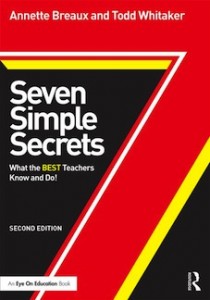How to Teach for Real Life Learning
In the next weeks, many new teachers will enter their own classrooms for the first time. To help them on their way, MiddleWeb is publishing a series of useful articles. Here’s our second excerpt from the new edition of Seven Simple Secrets. Also see: What an Effective Teacher’s Classroom Looks Like.

When asked the question “What is real-life teaching?” most teachers will respond that real-life teaching means relating the skills they teach to real life. They’re correct—partially. But they’ve quite possibly missed the key component in the definition of true real-life teaching.
You see, many teachers teach skills they believe the students will eventually need in their lives, but the problem lies in the fact that the skills are not taught in a way that interests the students. There’s no link, in the minds of the students, to their current lives. Real-life teaching means relating the skills you teach to the real lives of your students now!
Follow us into the classrooms of two teachers, only one of whom is truly teaching in a way that relates to the lives of the students.
The first teacher, Teacher A, is doing the best she can. She is not clear on the actual definition of real-life teaching. The second teacher, Teacher B, understands that to teach for real life means to teach every skill based on the importance of that particular skill to the real lives of her students.
Both are teaching their students about pronouns. First, let’s look in on Teacher A.
Teacher A: All about the future
Teacher A has the students take out their English books and open to page 24. After much balking and squawking, the students are finally ready to proceed.
Teacher A announces that today they will be learning about pronouns. She reads the definition from the text: “A pronoun takes the place of a noun.” She then points out the list of sample pronouns below the definition. Students are instructed to either write the definition of a pronoun in their notebooks (along with the list of sample pronouns) or type the definitions into their electronic notes.
Next, Teacher A writes a sentence on the white board that reads, “Bobby went to the store.” She then shows the students that the noun Bobby may be replaced with the pronoun He. Several other sentences are written on the board, and students are asked to replace select nouns with appropriate pronouns.

One student asks, “Why do we have to know this?” Teacher A responds by saying, “You need to know this so that you can speak English correctly. Without proper English, you won’t be able to get a decent job when you grow up.” This, of course, does not appease the student, as he fails to see the relevance of pronouns in his life today!
When this exercise is completed, Teacher A goes over the correct answers with the class. This, of course, is followed by Exercise B, and, finally, the dreaded worksheet on pronouns. The test, not surprisingly, will be on Friday.
The fact is that most of the students will probably pass the test. However, do any of the students know how their own lives would be drastically affected were pronouns to be removed from the language? Do they even know why pronouns exist?
Yes, they can state that a pronoun takes the place of a noun, but do they know why? Not unless they’ve figured this out on their own, and most have not.
Now let’s take a look at a very different kind of lesson, also on pronouns. This lesson occurs in the classroom of Teacher B.
Teacher B: All about “me” and “now”
Teacher B smiles enthusiastically and says, “I’ve written a list of words on the white board, and we are going to try not to use any of these words.” Note that he doesn’t yet mention the textbook, the term pronouns, or anything else for that matter. Instead, he asks Paul to tell something about himself without using any of the words on the board. (The words on the board, of course, are pronouns.)
Paul begins by saying, “I like to …” and Teacher B stops him immediately, saying, “You used the word ‘I,’ which is on the board.” Paul thinks about that and can’t seem to figure out how to say something about himself without using the word I. Teacher B then says, “Paul, I’ll give you a little time to figure it out while Beth gives it a shot.” Beth, of course, begins struggling also.
The teacher then explains that the students must refer to themselves by name. He provides an example, and the students seem to understand. But they laugh, because calling themselves by their own names sounds awkward. Students are then instructed to compose one sentence telling something about themselves without using any of the words on the board. The students then read their sentences aloud. They anxiously participate.
Next, the teacher projects a short paragraph onto the white board, right beside the pronouns already written on the board and says, “Let’s find all of the words in the paragraph that are also listed to the right of the paragraph on the board, and let’s cross them out.” The words they cross out must then be replaced with words that are not on the board.
In other words, they have to replace the pronouns with the nouns that the pronouns are representing. However, the terms pronouns and nouns have not yet been used by the teacher. The paragraph, of course, sounds awkward once the pronouns have been replaced.

You see, it has already become obvious to the students that these words, whatever they are, are necessary to our language. Without them, it would be very awkward to speak or to write, or even to think, for that matter.
Finally, the teacher does tell the class that these words are called pronouns and that pronouns take the place of nouns. He has the students explain what just happened in the preceding activities and discuss how awkward it was not to use these pronouns.
“So why do you think we have pronouns in our language?” asks the teacher. Any student in this classroom has already figured out that pronouns don’t just take the place of nouns for the sake of taking the place of nouns, but rather they make the language flow smoothly and sound less awkward.
The fact is that all of our lives would be drastically affected were pronouns to be taken out of the language. We would have trouble completing a sentence, much less getting our points across to others.
Make it relevant
Do you see the difference that it makes once students know how a skill they are learning affects their lives? If something seems relevant to us, we become interested. And once we are interested, we are more apt to learn whatever it is that is relevant!
Please understand that we are in no way opposed to the use of textbooks. Teacher B actually went on to use one of the exercises in the textbook after he had established the real-life relevance of pronouns.
To attempt to teach anything to anyone without first establishing a real-life connection is practically futile. And that is one of the keys to what sets the very best teachers apart from the rest—they relate all lessons to the real lives of their students, today!
We stress the word today because many teachers, like Teacher A, explain to their students that the skill will be important someday when they are grown. Children cannot relate to someday. Even high school seniors are capable of thinking only as far into the future as Friday night!
So make your lessons exciting and inviting by relating what you teach to the students’ lives today.
Here’s another bonus download:
► 7 Things Effective Teachers Love about Teaching.
Editor’s note: This is the second of three excerpts that MiddleWeb is sharing from the just-published 2nd edition of the bestseller Seven Simple Secrets: What the BEST Teachers Know and Do! by Annette Breaux and Todd Whitaker. Thanks to Lauren Davis at Routledge/Eye on Education for helping us gain permission to offer these posts.
___

Todd Whitaker is a professor of educational leadership at Indiana State University and a prominent education author and speaker. Whitaker has taught at the middle and high school levels, served as a secondary school principal for eight years and as a district-level middle school coordinator. His many books include Leading School Change, What Great Principals Do Differently, What Great Teachers Do Differently and The 10-Minute Inservice. Follow him on Twitter @ToddWhitaker.



































